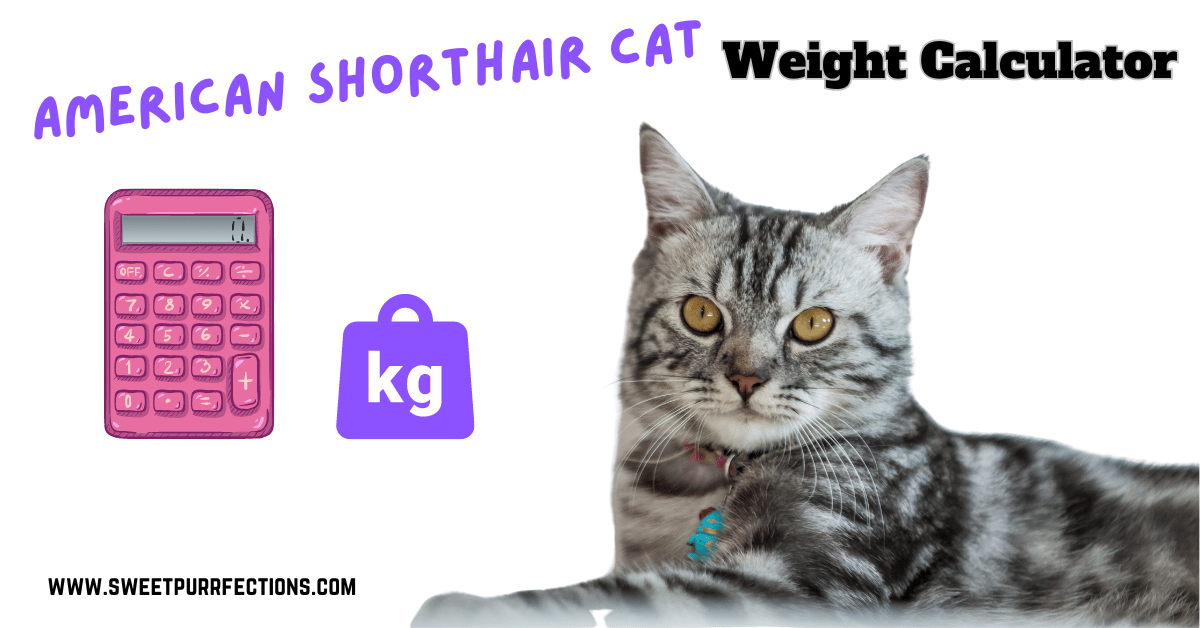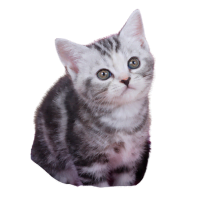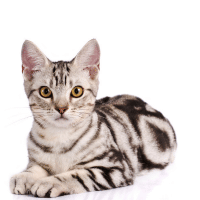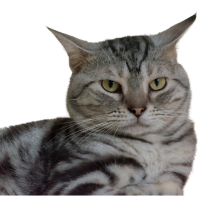This post contains affiliate links and I will be compensated if you make a purchase after clicking on my links.
How the American Shorthair Cat Weight Calculator Works?
Curious about the ideal weight for your American Shorthair at different life stages? Our easy-to-use weight calculator is here to guide you through the process. Just follow these numbered steps:
- Select the Unit of Measure: Choose your preferred weight unit.
- Select the Sex of Your Cat: This selection allows the calculator to provide a more accurate weight estimate based on average weights for each sex.
- Enter Your Cat’s Age: Please fill in only the fields that correspond to your cat’s age. You may use one or multiple fields as applicable.
- Calculate the Weight: The calculator will compute an estimated weight range for your cat, based on its age and sex.
American Shorthair Weight Calculator
Exploring the Physical Traits of the American Shorthair
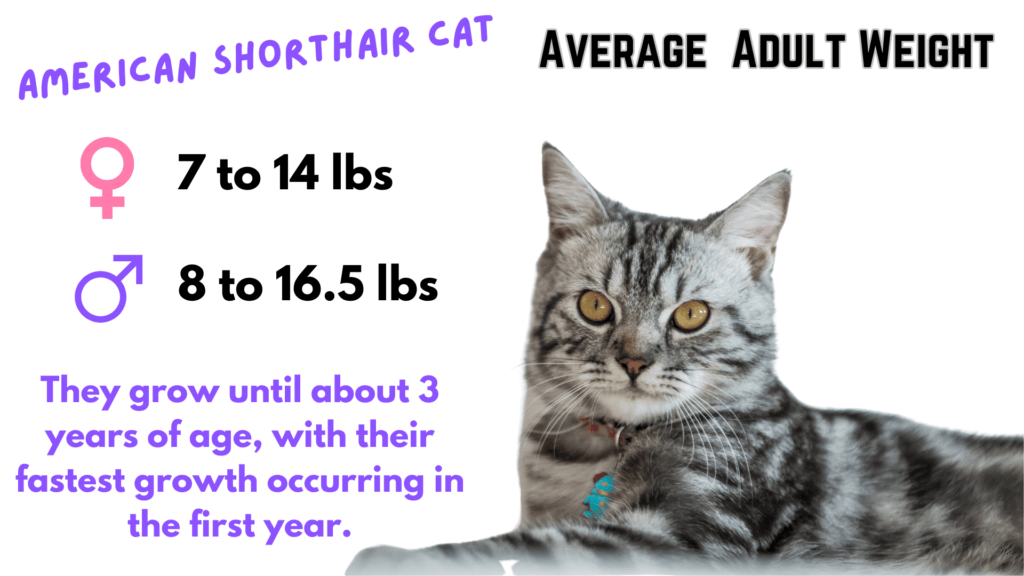
The American Shorthair cat features a striking design that balances form and practicality. These medium to large cats have a muscular and robust build. Males usually weigh between 8 to 16.5 pounds, while females range from 7 to 14 pounds, showcasing a stocky physique that distinguishes them from their British counterparts.
Their round heads and powerful bodies aren’t just for show; these features hint at their European heritage and their historical role as pest controllers on transatlantic voyages.
Key Features
- Size: Medium to large
- Weight: Males 8-16.5 lbs, Females 7-14 lbs
- Build: Muscular and stocky
- Head Shape: Round
Growth and Development Milestones
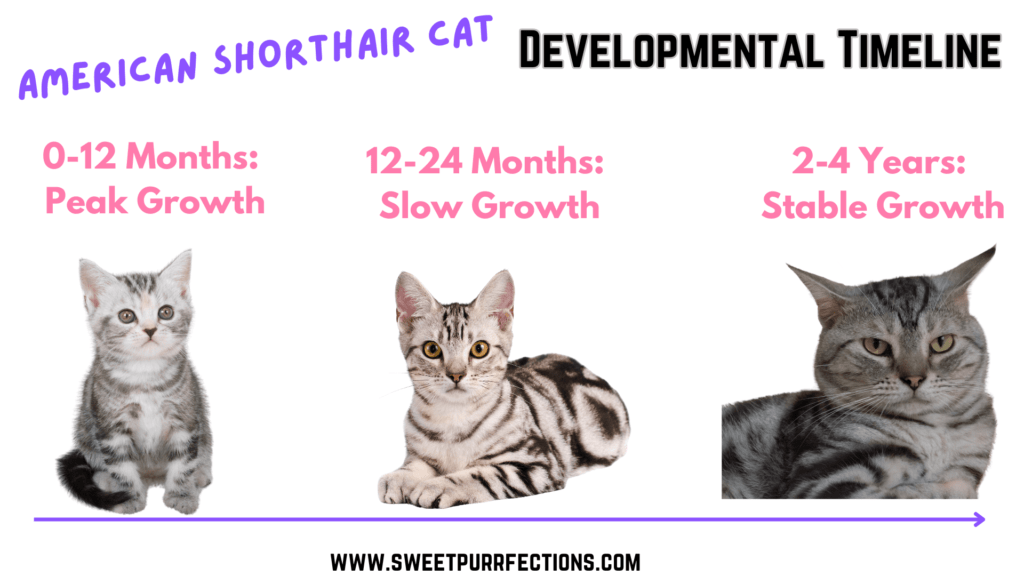
American Shorthairs typically experience an extended growth period, with most reaching full physical and behavioral maturity by the age of three. However, some may continue to develop, albeit at a much slower rate, up to four years of age. The most significant growth occurs within the first year, during which they quickly build the foundations of their physique and temperament.
After the initial surge, the growth rate decelerates. By the age of two, the changes become subtler and less frequent. It’s important to monitor their size and health closely during this time to prevent obesity, which involves managing their diet and exercise appropriately.
Developmental Timeline
- 0-12 months: Peak growth phase.
- 12-24 months: Slower growth; ongoing development.
- 2-4 years: Growth stabilizes as they reach full maturity.
Monitoring Weight and Health in American Shorthairs: Why It's Crucial
American Shorthairs are robust and adaptable cats, but maintaining a healthy weight is essential for their well-being. Regular weight checks are crucial as both overweight and underweight conditions can indicate health issues. It’s important to remember that the weight ranges provided earlier are merely estimates, and some American Shorthairs may fall outside these numbers yet still be perfectly healthy.
Key Considerations for Weight Management
- Regular Weigh-Ins: Regularly weighing your American Shorthair is vital for monitoring their health. Sudden changes in weight, whether loss or gain, need careful attention.
- Healthy Weight Ranges: Typically, male American Shorthairs should not exceed 17 pounds and females should stay below 14-15 pounds in adulthood. Being above these weights might indicate that they are overweight. Similarly, any adult American Shorthair weighing less than 7 pounds could be considered underweight, signaling potential health issues.
- Monitoring for Red Flags: Significant deviations from the standard weight ranges warrant further veterinary evaluation. Underweight conditions can be just as harmful as obesity, affecting your cat’s overall health and vitality.
- Understanding the Body Condition Score (BCS): The BCS is a helpful scale that assesses the health of your cat based on their fat levels and muscle mass. It helps determine if their weight is healthy for their size and build.
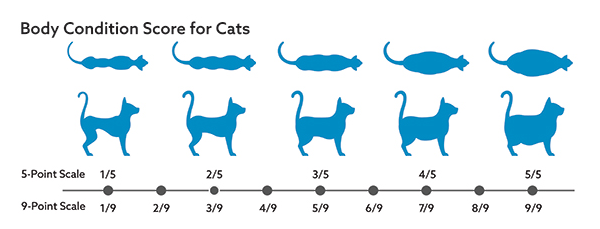
Pro Tip: Always pair the Body Condition Score (BCS) with your American Shorthair's actual weight to get a comprehensive view of their health. This combination helps you accurately determine if your cat is at a healthy weight, taking into account both their physique and any weight changes.
Factors Influencing the Weight of Your American Shorthair
Keeping your American Shorthair at a healthy weight is not just about diet and exercise—it's influenced by a variety of factors. Here's what every cat lover should consider when monitoring their feline friend's weight:
- Genetics: Your cat's genes set the baseline. Some American Shorthairs are naturally bigger or smaller due to their genetic makeup.
- Diet: What’s on the menu matters a lot. High-quality cat food in the right amounts ensures your cat stays energized without tipping the scales.
- Exercise: Keep them moving! Regular play sessions and activities help burn calories and keep your cat in sleek shape.
- Health Status: Watch out for signs of Hypertrophic Cardiomyopathy, a common concern in American Shorthairs. Also, keep an eye out for dental diseases, ear infections, and skin conditions, which can all affect your cat’s overall health and weight.
- Neutering/Spaying: Post-surgery, your cat’s dietary needs may change. They often require fewer calories, so portion control is key to avoiding weight gain.
- Environment: A stress-free environment and plenty of space can encourage more active behavior, helping to maintain a healthy weight.
- Age: Kittens zoom around and burn more calories, but as cats age, their metabolism downshifts. Adjusting their diet and their calorie intake as they grow older can prevent unwanted weight gain.
Weight Management for Your American Shorthair: Three Common Scenarios
Managing your American Shorthair's weight effectively involves understanding where they stand in relation to standard weight guidelines and their Body Condition Score (BCS). Here are three scenarios you might encounter and how to handle each:
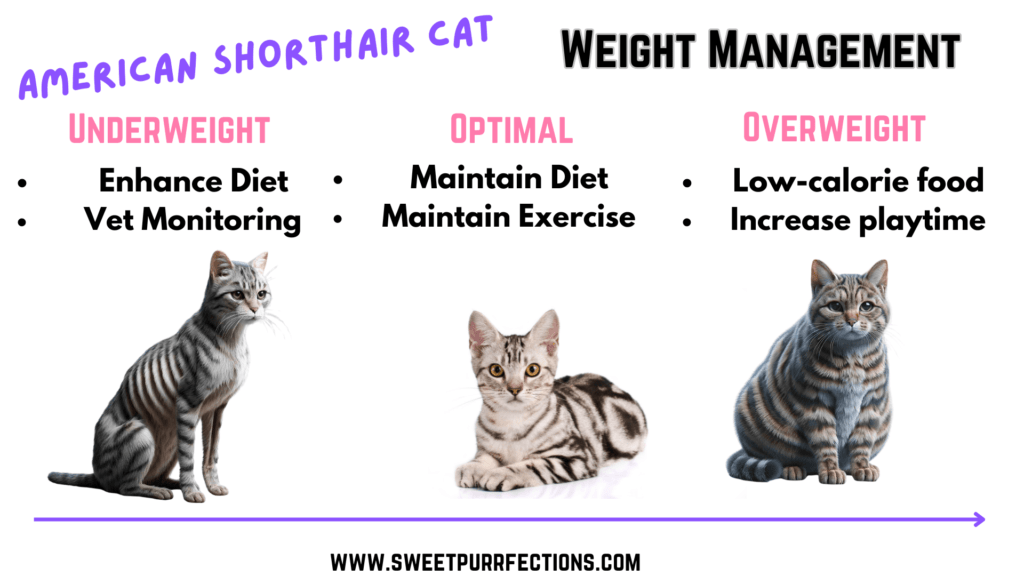
1. Weight Matches BCS Indications (Overweight or Underweight)
If your cat's weight is either above or below the estimated range suggested by the American Shorthair weight calculator, and their BCS aligns with this (either showing overweight or underweight):
- Overweight: Increase their exercise routine gradually, adjust their diet to lower-calorie foods, and consider portion control. Regular vet check-ups are crucial to monitor health impacts and adjust strategies as needed.
- Underweight: This might indicate a need for dietary adjustments, such as more frequent or richer meals, depending on their health condition. A vet visit is essential to rule out any underlying health issues causing the weight discrepancy.
2. Weight Deviates from Estimates but BCS Indicates Healthy
If your American Shorthair's weight differs from the estimates provided by our American Shorthair Cat Weight Calculator, yet their Body Condition Score (BCS) indicates they are healthy, this may suggest that your cat naturally falls outside the standard weight ranges due to unique factors such as bone structure or muscle mass.
Although your cat might not match the average, a healthy BCS is a reliable indicator of good health.
3. Optimal Weight and Healthy BCS
If your American Shorthair is within the weight range suggested and the BCS confirms they are at an optimal weight:
- Keep up the great work! Continue with your established routine of balanced diet and regular exercise to maintain their health.
- Regular health check-ups are important to ensure that your cat remains at this ideal weight, and to adjust care as needed as they age.
Closing Thoughts: American Shorthair Weight Tools
Successfully managing the weight of your American Shorthair cat plays a critical role in ensuring their overall health and longevity. By utilizing the American Shorthair Cat Weight Calculator along with regular checks of their Body Condition Score, you can tailor their diet and exercise to meet their specific needs.
Whether your furry companion is above, below, or at their ideal weight, consistent monitoring and adjustments—guided by professional veterinary advice—will keep them thriving.
Meet Sean, a fintech whiz with a penchant for pet purrs and blockchain buzz. After a decade of fintech feats, Sean's tech talents leaped from ledger lines to litter lines, driven by a passion for pets and a vision for a more connected pet care community. With three critter companions as co-pilots, Sean launched this blog to share a treasury of pet-friendly tech tips and tales.

